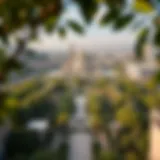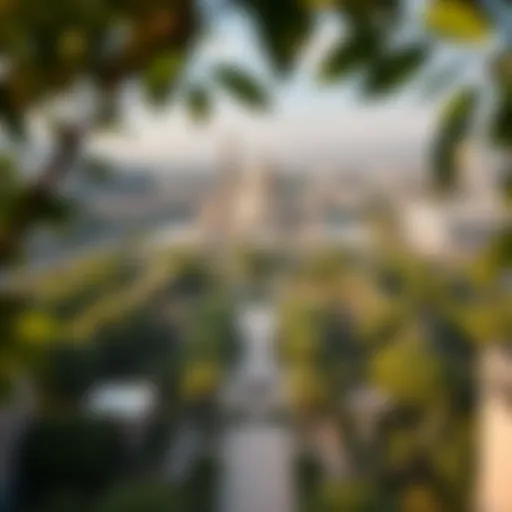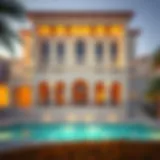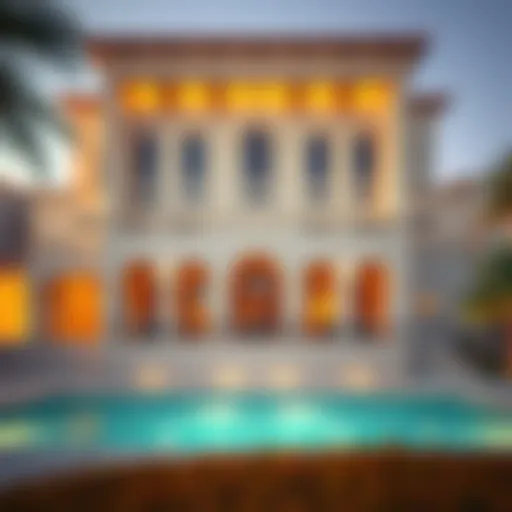Examining Palladian Properties in Dubai Real Estate
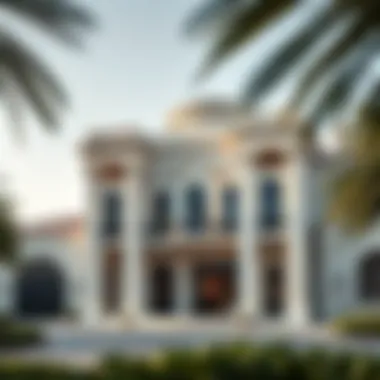

Intro
The Dubai real estate market is as dynamic as the urban environment it shapes. Among the many architectural styles vying for attention, Palladian properties stand out for their classic elegance and historical significance. These structures, inspired by the 16th-century architect Andrea Palladio, infuse a sense of permanence and style into the fast-paced world of modern real estate.
In this discussion, we’ll peel back the layers of what makes Palladian architecture so appealing in Dubai. Key elements include the hallmark symmetry, grand porticos, and the use of Ionic and Corinthian columns that characterize this design. More than just a matter of form, the style embodies an ethos of beauty and balance, resonating with the aspirations of buyers and investors alike. By understanding what Palladian properties entail, one can more thoughtfully navigate the intricate web of Dubai's real estate offerings.
Now, let's delve deeper into the nuances that comprise the market insights regarding Palladian properties.
Preface to Palladian Architecture
Palladian architecture has carved out a unique niche in the realm of architectural styles, standing as a testament to elegance and classical sophistication. Understanding this style is crucial, especially when examining its integration into the modern landscape of Dubai's real estate market. The significance of Palladianism lies not just in its aesthetic attributes but also in its historical context and the values it embodies. Properties built in this style relate closely to notions of stability, harmony, and proportion, catering to a demographic of buyers who are not merely looking for a house but a lifestyle steeped in a rich historical narrative.
In the context of Dubai, the infusion of Palladian principles transforms the city’s already diverse skyline into something extraordinary. The local market benefits from this architectural approach by attracting discerning buyers seeking more than just modern conveniences. They desire properties that possess character and elegance, which Palladian architecture readily provides. To grasp the relevance of this design style in Dubai, one must consider how it harmonizes with the region's burgeoning luxury market and evolving architectural trends, appealing to affluent investors and expatriates alike. By delving into its defining characteristics and historical background, we will uncover how Palladian architecture contributes to the ongoing dialogue about aesthetic trends, investment values, and cultural significance in the emirate.
Defining Palladian Style
At a glance, Palladian architecture is characterized by a select few key elements: symmetry, classical proportions, and a strong emphasis on columns. This style draws inspiration from the works of Andrea Palladio, a 16th-century Italian architect whose principles have been adopted worldwide. But what does this mean for the properties in Dubai?
When we say a property is Palladian style, it evokes images of grand facades, meticulously designed entryways, and expansive windows that invite natural light to flood interiors. Each aspect is thoughtfully proportioned, creating a balance that is aesthetically pleasing. The use of columns and porticoes is particularly noteworthy, often giving buildings a sense of permanence and strength, qualities that resonate deeply in regions where architectural statements reflect wealth and status.
Historical Context of Palladianism
To appreciate the impact of Palladianism in today's Dubai, one must travel back to its inception. Originating in the Renaissance period, Palladian architecture is steeped in the revival of classical Greek and Roman ideals. The philosophical underpinnings of this movement provide insight into why modern adaptations continue to thrive in diverse locations, including Dubai.
The historical significance of Palladian architecture can be traced to how it emphasizes rationality and beauty, principles that align with the zeitgeist of the Enlightenment era. As architecture began to evolve, Palladian designs emerged as symbols of education and virtue in many Western societies. This historical context adds layers to the understanding of current architectural trends in Dubai, where the juxtaposition of tradition and contemporary flair often creates striking visuals in the urban landscape.
Indeed, as one surveys the Dubai skyline, it becomes clear that the allure of Palladian properties is as much about their historical reverberations as it is about their modern-day luxuries. Investors and homebuyers are not only purchasing a residence but also a piece of an architectural legacy that spans centuries.
Key Characteristics of Palladian Properties
Palladian properties are marked by distinct features that define not only their aesthetic appeal but also their functional integrity. Each of these characteristics is significant, especially in the vibrant real estate market of Dubai, where architecture needs to stand out amidst a backdrop of lavish designs and modern conveniences. A deeper understanding of these key traits can guide potential buyers, investors, and enthusiasts in appreciating what makes these properties unique and desirable.
Symmetry and Proportionality
Symmetry is at the heart of Palladian architecture. It reflects a sense of balance that often resonates with purists and modern architects alike. The skilled arrangement of structures ensures that every corner is aligned, giving an air of calm and order. This is not just about visual appeal; it plays a crucial role in how light interacts with building spaces, enhancing the feel of openness.
When it comes to proportionality, Palladian properties tend to adhere to classical ratios that create harmony across different elements. For instance, a Palladian villa might feature a façade where windows and doors are meticulously sized relative to the overall structure. Investors should consider this feature as it can significantly influence property valuation. Well-proportioned designs often see higher demand in real estate markets, thereby enhancing resale values over time.
Use of Columns and Porticos
Columns and porticos serve as hallmarks of Palladian design. These architectural features do more than just support the structure; they invoke a sense of grandeur and elegance that is often associated with classical antiquity. Columns can be designed in various styles—Doric, Ionic, or Corinthian—allowing for personalization that can reflect a homeowner's taste.
Porticos, on the other hand, act as transitional spaces between the inside and outside, establishing a welcoming presence. In Dubai’s climate, having a shaded entrance can be both functional and a stylistic statement. Prospective buyers should evaluate how these elements contribute to the overall charm and functionality of the property, taking note of their construction quality and aesthetic alignment with the surrounding environment.
Incorporation of Natural Light
Natural light is intricately woven into the fabric of Palladian architecture. This isn’t simply about installing large windows; it’s about strategically positioning them to capture the sun’s path. By doing so, these properties benefit from increased spatial awareness and a lively, inviting atmosphere.
The abundance of natural light also plays a significant role in reducing energy costs, aligning with modern sustainability trends. Buyers often desire homes that are energy-efficient, and properties that are designed with light in mind typically have lower utility bills, making them more appealing in a competitive market.
% It's essential for buyers to look at these aspects when considering a Palladian property, as thoughtful design choices can translate into significant long-term savings and enhanced living conditions.
In summary, understanding these key characteristics can greatly inform decisions in the dynamic environment of Dubai's real estate. Whether someone is an investor eyeing prime real estate or a homebuyer seeking beauty and practicality, appreciating the intrinsic values of symmetry, columns, and natural light in Palladian properties can lead to wiser investments and more satisfying living experiences.
Palladian Influence in Global Architecture
Palladian architecture has vastly shaped buildings around the globe, and its influence is ever present in modern designs. This significance stems not only from the aesthetic appeal but also the philosophical underpinning of harmony, symmetry, and proportionality. In the realm of Dubai's real estate, it becomes essential to understand how global architectural trends, especially the Palladian influence, steer local preferences and investments.
Palladianism Across Continents
The term "Palladianism" describes not just a style but a movement that echoing in various architectural forms across continents. Originating in the 16th century with Andrea Palladio, the style made its way overseas during the colonization periods. Cities in North America, Australia, and even parts of Asia adopted these principles, reinterpreting them through local cultural lenses.
- North America: Many government buildings and mansions are designed with Palladian features. You find this in Thomas Jefferson's Monticello and the Virginia State Capitol, indicating the deep-seated respect for classical ideals.
- Australia: Here, the influence also got a boost with grand public spaces and homes echoing Palladian designs. Notably, in Melbourne, you see it reflected in the State Library's classic structure.
- Asia: Countries like India have embraced Palladian principles in some of their colonial buildings, creating a striking blend of local craftsmanship with European styles.
The Palladian style travels well across borders, yet it often molds itself according to local traditions, effectively bridging cultures. This adaptability plays a significant role in its enduring appeal, showing that the structuring of space can resonate across diverse societies, enhancing communal and individual experiences.
Prominent Palladian Structures Worldwide
Spotting Palladian structures around the world offers a fascinating glimpse into how architectural philosophies are expressed. These buildings often reflect both grandeur and meticulous attention to detail, standing as testaments to their creators’ ambitions. Here are a few noteworthy examples:


- Villa Almerico Capra "La Rotonda" (Italy): This iconic villa symbolizes Palladian architecture, featuring a rotunda and porticoes that have inspired countless architects over centuries.
- Chiswick House (England): A perfect example of Palladian style in Britain, Chiswick House is known for its symmetry and classical elements, making it an important heritage site.
- The White House (USA): An embodiment of Palladian influence in American architecture, it reflects both stylistic and political aspirations, presenting as a symbol of unity and power.
- Bank of New South Wales (Australia): Located in Sydney, this building is a remarkable blend of Palladian proportions with local styles, showing the transition of high design into civic life.
- Raja Ravi Varma's Palace (India): This stunning structure incorporates local elements while maintaining the Palladian-esque facades, making it a hybrid marvel of architecture.
"The beauty of Palladian architecture lies in its timeless nature, transcending geographic and cultural boundaries, yet remaining rooted in the philosophical principles of stability and harmony."
Learning about these prominent structures does more than celebrate the art of buildings; it reveals how societies valued architecture as a reflection of their ideals. As one ponders investment opportunities in Dubai, recognizing such historic value is vital. The Palladian legacy can influence choices, whether one is buying a home or looking for a high-value property that tells a story of artistry and endurance.
Palladian Properties in Dubai
Palladian properties have emerged as notable features in Dubai's diverse real estate landscape. This architectural style, distinguished by its elegance and symmetry, resonates with many who are looking for an aesthetic that balances tradition with modernity. Specifically, Palladian designs offer distinctive elegance and timeless appeal that attract both investors and homeowners alike. As Dubai continues to grow as a premier global city, the integration of Palladian architecture within its luxury properties reflects a desire for sophistication and cultural depth.
Emergence of Palladian Design in Dubai
Over the last couple of decades, Dubai has become a melting pot of architectural influences. The emergence of Palladian design can be attributed to the city's progressive vision which seeks to blend the old with the new. With architects and developers keen on creating landmarks that are steeped in historical significance, the Palladian style has gained traction. Many structures designed in this fashion evoke a sense of grandeur, where visitors feel they are stepping into a reliable piece of history, even amidst the ultramodern skyline.
The initial foray into Palladian design was spurred by the increasing appeal of classical architecture among affluent buyers and expatriates. A pivotal moment occurred when several developers recognized the importance of integrating heritage aesthetics with advanced construction technologies. With this shift, project portfolios expanded, showcasing homes, villas, and commercial spaces that reflect Palladian principles.
In the heart of Dubai, areas like Dubai Hills Estate and Arabian Ranches started to see properties taking inspiration from Palladian designs, thus offering buyers a mix of comfort and grandeur. The thoughtful design allows for open-plan living, coupled with features like expansive porticos and well-proportioned spaces, creating an ambience that embodies luxury.
Notable Palladian Real Estate Developments
Several standout developments in Dubai exemplify the fusion of Palladian architecture with contemporary living. Jumeirah Bay Island, for instance, houses a selection of luxurious estates that showcase striking columns and expansive facades reminiscent of Palladian ideals. This development not only provides residents with serene views but also embraces classical design elements that elevate its status in the luxury real estate market.
Another impressive example is The villas at The Springs, where homebuyers are presented with properties that incorporate Palladian concepts through careful attention to symmetry and natural light. With attractive frontages, these villas create a continuous dialogue between the indoors and outdoors, encapsulating the essence of Palladian design.
"Palladian properties in Dubai provide a unique opportunity for buyers who appreciate a blend of historical significance with the comforts of contemporary living."
Finally, Palace Residences, set against the beautiful Dubai Creek, articulates the grandeur associated with Palladian architecture. Here, the balance of historical design and luxurious amenities appeals to discerning homebuyers looking for not just a house, but a lifestyle defined by elegance and richness.
Market Trends Surrounding Palladian Properties
In the landscape of Dubai's real estate, market trends surrounding Palladian properties have gained considerable traction. This uptick represents not just a passing fad, but rather a pivotal shift in what luxury living signifies in this iconic city. As investors and homebuyers grapple with an ever-evolving market, understanding these trends is essential for making informed decisions. Factors such as architectural allure, historical significance, and cultural resonance make Palladian properties increasingly attractive.
Demand Dynamics
The demand for Palladian properties in Dubai is shaped by various elements. Luxury buyers are increasingly seeking homes that offer not only comfort but also aesthetic appeal. The timeless elegance and almost regal feel of Palladian design fit this bill perfectly. The spacious layouts and grand façades capture attention, making these homes desirable for expatriates and affluent locals alike.
- Cultural Affinity: Many potential buyers have a penchant for historical architecture, which lends an extra layer of desirability to Palladian styles. The classic elements of symmetry and proportion resonate with those who value a connection to tradition, even in a modern context.
- Investments in Lifestyle: People are no longer just looking for a place to live; they desire a lifestyle. Palladian properties symbolize an upscale way of life, aligning with aspirations of comfort and prestige. This association enhances demand, propelling property values higher.
As supply tightens in a thriving market, it further pushes potential buyers to engage with these luxury options. With so many factors at play, one can see how the currents of demand are shaping the narrative around Palladian real estate.
Comparative Valuation
Evaluating the worth of Palladian properties compared to other architectural styles reveals intriguing insights. These homes often command a premium in the market, reflective of their distinctiveness and perceived value. Understanding how buyers assign worth to these properties can clarify investment potentials.
- Value Appraisal Factors: Several features contribute to the comparative valuation. Quality of materials, craftsmanship, and location play significant roles. Properties that incorporate high-end finishes and unique design details tend to attract a higher market price.
- Market Comparisons: When set side-by-side with contemporary projects, Palladian properties often hold stronger long-term value. Their historical style provides a buffer against market fluctuations, drawing buyers who appreciate the legacy of architecture. This can result in more stable resale values over time.
To grasp the market position of Palladian properties, one must consider both the intrinsic values of architecture and the motivations behind buyer preferences.
In summary, the interplay of demand dynamics and comparative valuation not only influences the current market trends but also lays the groundwork for future investments in Palladian properties in Dubai. By staying attuned to these fluctuations, investors can position themselves for strategic decision-making in an increasingly sophisticated real estate environment.
Investing in Palladian Properties
Investing in Palladian properties holds a significant role in the Dubai real estate scene. With the growing appreciation for unique architectural styles, particularly in a city known for its luxe offerings, Palladian homes have found a niche. These properties not only provide aesthetic appeal but also command a certain prestige in the market. Therefore, understanding the nuances of investing in such properties is essential for anyone looking to navigate the property landscape in Dubai.
Key Considerations for Buyers
When you're considering purchasing a Palladian property, there are various factors buyers should keep in mind:
- Architectural Integrity: Palladian design is characterized by its elegance and meticulous detailing. Buyers should assess whether the property maintains its architectural integrity and adheres to traditional Palladian elements, like symmetry and classical columns. This affects not only enjoyment but also the property's long-term value.
- Location: Some areas of Dubai are more saturated with luxurious properties than others. A well-placed Palladian home in a sought-after neighborhood can appreciate significantly over time. Investigating the surrounding amenities, accessibility, and growth potential of the area is vital before making a decision.
- Historical Value: The historical significance of Palladian-style properties can enhance their appeal. Properties that boast rich narratives or connections to the architectural greats often attract buyers who are not just looking for a home, but also a piece of history.
- Market Trends: Keeping an ear to the ground regarding market trends can help buyers predict fluctuations in property values. Understanding when to buy can mean the difference between a great investment or a financial misstep.
Risk Factors and Mitigation Strategies
While investing in Palladian properties offers many rewards, it’s crucial to identify and mitigate potential risks:
- Market Fluctuations: The real estate market can be volatile. Buyers should research current market conditions and future forecasts. Staying informed through reputable sources like Dubai Land Department can equip investors with the necessary data.
- Maintenance Costs: Given their intricate designs, Palladian homes might demand higher maintenance costs. Evaluating the age of the property and estimating future upkeep should be included in the budget. A property inspection by a qualified professional can unveil potential hidden costs.
- Regulation Changes: Real estate regulations can shift, affecting ownership and rental laws in Dubai. Buyers should engage with local real estate experts to navigate these regulations effectively. Keeping track of governmental updates can prevent unexpected challenges down the road.
- Liquidity Risk: In a niche market such as Palladian properties, finding buyers may take time. Investors should remain patient and consider holding strategies, possibly including rental options to offset costs while waiting for resale.
In summary, investing in Palladian properties involves a careful balancing act between appreciating their unique attributes and being mindful of the broader market dynamics. By considering various factors and putting in place effective risk management strategies, buyers can make informed decisions that align with their real estate goals.
The Role of Palladian Properties in Luxury Living
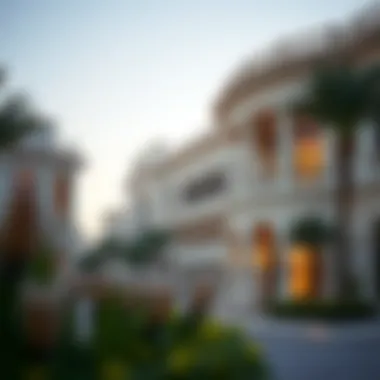

Palladian properties in Dubai exemplify a unique intersection between tradition and modernity within the luxury real estate market. The elegance and refined aesthetics that define Palladian designs not only enhance individual living spaces but also elevate entire neighborhoods. Here, we delve into how these properties shape the luxury market, their cultural significance, and what they mean for various stakeholders in Dubai’s ever-expanding real estate landscape.
Luxury Market Positioning
In the luxury real estate sector, positioning is key. Palladian properties, with their grand scale and meticulous attention to detail, stand out amidst the competition. They often command higher prices due to their architectural pedigree and the lifestyle they promote. The demand for such homes isn't just about having a roof over one's head; it’s increasingly about the statement they make.
Some reasons why Palladian architecture thrives in the luxury market include:
- Timeless Appeal: The classical elements evoke a sense of sophistication that aligns with buyers looking for exclusivity.
- Customizability: Many Palladian properties offer extensive options for personalization, allowing buyers to infuse their own tastes.
- Location: These homes are frequently situated in prime areas of Dubai, which naturally attracts affluent buyers.
Moreover, developments featuring Palladian styles often come with a complete package of luxury amenities—from lush gardens to state-of-the-art security systems. This positioning attracts not just buyers but investors wanting high-value assets.
Cultural Significance of Luxury Palladian Estates
The allure of Palladian estates goes beyond mere aesthetics; they play an essential role in shaping cultural landscapes. In cities like Dubai, where east meets west, the fusion of Palladian architecture with local influences results in a vibrant cultural dialogue. This architecture serves as a canvas that reflects the aspirations of the region’s diverse populace.
From a cultural standpoint, the significance of these properties includes:
- Heritage Influence: They often draw inspiration from historical influences, fostering a sense of continuity in a rapidly changing urban environment.
- Community Identity: These estates contribute to the identity of their neighborhoods, providing a landmark that is both inspiring and aspirational.
- Artistic Expression: Beyond living spaces, Palladian properties often function as galleries, showcasing art, sculpture, and design influences that resonate with high-net-worth individuals.
As such, while Palladian properties are certainly luxurious, they are also vibrant cultural touchstones. These estates not only define luxury living but also reflect the evolving culture of Dubai.
"Luxury is not the absence of something, but rather the presence of everything that symbolizes a high quality of life," a sentiment that truly reflects the essence of Palladian living.
Sustainability in Palladian Designs
Sustainability in architectural design has become a crucial conversation in recent years, especially in cities as sprawling and development-driven as Dubai. Palladian architecture, with its classic roots and dominant features, is finding new avenues for integration with sustainable practices. As the world shifts toward greener alternatives, exploring sustainability within Palladian designs offers insights into not only preserving the integrity of such timeless structures but also meeting the modern demands of eco-conscious living.
The significance of sustainability in Palladian properties is manifold. First, implementing eco-friendly strategies often leads to long-term cost savings. Buildings that harness natural light and use efficient materials can reduce energy expenses significantly. Moreover, with Dubai’s hot climate, designing structures that maintain a cool environment with less energy consumption is a necessity. Secondly, sustainability enhances the overall appeal of properties. Investors and buyers are looking for properties that not only look good but are also environmentally friendly, adding value to their investments.
Key Elements of Sustainable Palladian Designs:
- Natural Materials: Using materials that are locally sourced helps in minimizing the carbon footprint.
- Energy Efficiency: Incorporating modern technology like solar panels in the traditional Palladian framework.
- Water Conservation: Designing landscapes that require minimal irrigation while maintaining aesthetic charm.
Benefits to Consider:
- Increased market value due to eco-friendliness.
- Potential tax incentives for developers implementing sustainable practices.
- Aligning properties with government sustainability goals enhances reputation.
Overall, the fusion of sustainability with the classic principles of Palladian architecture not only preserves its beauty but also positions it as a forward-thinking choice in Dubai's real estate market.
Modern Adaptations for Sustainability
As the principles of Palladian architecture are rooted in symmetry and classical aesthetics, adapting them for modern sustainability requires a delicate balance. Architects today face the task of staying true to the traditional style while incorporating advancements in green technology.
One prominent adaptation involves utilizing high-performance glazing in large windows and porticos. These windows maximize natural light, reducing reliance on artificial lighting. The incorporation of materials like reclaimed wood for structural elements or flooring preserves the aesthetic of classic Palladian design while promoting renewable sources.
Additionally, many modern Palladian houses in Dubai are being built with insulated walls and roofing materials. These elements ensure they remain comfortable year-round, which also contributes to significant energy savings. Smart home technology has also found its way into these designs, allowing residents to control energy efficiency measures with ease. By placing sensors to monitor energy use, these homes become proactive spaces that not only look stunning but also operate efficiently.
Case Studies of Eco-friendly Palladian Properties
Examining real-life examples offers a glimpse into how sustainability can coalesce harmoniously with Palladian principles. One noteworthy example is the Villa 21 located in Emirates Hills. This property incorporates green roofs to provide insulation against the extreme Dubai heat while retaining the charming, pillared façade characteristic of Palladian style. By using solar panels discreetly integrated into the roof design, it produces its own energy without compromising aesthetics.
Another striking instance is the Al Barari Subdivision, a residential area known for its eco-friendly designs. Many of the houses mirror Palladian ideals, featuring large windows and vast gardens. The community actively promotes a green lifestyle through sustainable landscaping and water efficient systems. The designs retain the elegance of classical architecture while addressing modern environmental demands.
"The marriage of sustainability with Palladian elegance results in properties that are not just beautiful, but responsible."
Community Impact of Palladian Properties
The impact of Palladian properties on the community extends beyond mere aesthetics; they forge connections, enhance urban landscapes, and often act as a catalyst for cultural appreciation. In Dubai, where architectural marvels are already a hallmark, Palladian designs add a layer of sophistication, blending classic elegance with modern functionality. This fusion not only enriches the skyline but also nurtures a sense of identity and pride among residents.
Enhancing Urban Aesthetics
Palladian properties help create an appealing urban environment, fostering a visual harmony throughout the community. Their symmetrical design principles and thoughtful proportions invite admiration, making them stand out amidst the often-glitzy background of contemporary structures. When a Palladian-style building arises, it often becomes a conversation starter, drawing attention to the elegance of its porticos and the graceful arrangement of its columns.
- Architectural Consistency: Buildings constructed in the Palladian style help maintain a uniformity that can unify various structures throughout the surrounding area.
- Landscaping Opportunities: The natural alignment of these properties permits beautiful landscaping that can enhance public spaces, inviting people to gather and interact, thereby strengthening community ties.
The elegance of Palladian architecture can elevate a neighborhood's overall perception, attracting not just residents but also tourists and investors who appreciate the artistry involved in such designs. \
Moreover, incorporating Palladian properties within suburbs helps contribute positively towards enhancing local ecosystems, as many designs emphasize coherence between architecture and nature, allowing green spaces to coexist comfortably within urban terrains.
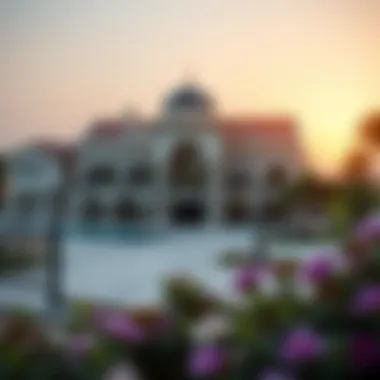

Influence on Local Culture and Heritage
Palladian properties carry profound cultural implications, often reflecting the historical narratives of their surroundings. By adopting a style that draws inspiration from classical architecture, these properties reverberate with stories of past societies, serving as tangible links to cultural heritage. In a city like Dubai, known for being a melting pot of cultures, the introduction of such designs can invite a richer dialogue about history and architecture.
- Preservation of Cultural Identity: By integrating Palladian influences into new constructions, communities maintain a dialogue with their historical roots. This effort can resonate strongly with residents who cherish their heritage and wish to see it honored in contemporary developments.
- Educational Opportunities: Communities can leverage Palladian properties as educational landmarks. Schools and institutions in the area might use these structures as case studies for architecture or design classes, turning buildings into real-world learning environments.
As a result, Palladian properties do more than physically inhabit their surroundings; they weave a sense of belonging that speaks to both legacy and modern aspirations. Such architectural styles encourage neighborhoods to reflect on their unique cultures, creating a societal fabric rich in diversity while simultaneously fostering a collective identity.
Challenges Facing Palladian Properties
The exploration of Palladian properties in Dubai's real estate market certainly isn’t without its hurdles. These challenges impact both the potential success of property investments and the allure of Palladian-design homes. Understanding these obstacles is crucial for investors, homebuyers, and real estate agents looking to make informed decisions in a competitive market.
Market Saturation
In recent years, Dubai's skyline has witnessed a surge in lavish and prestigious properties, many of which draw heavily from Palladian architecture. However, this growth has led to a noticeable saturation in the market. This oversupply has implications for prospective buyers. With too many options, it can be challenging for properties to stand out.
Moreover, what was once a desirable feature—palladian characteristics such as grandeur and symmetry—may start to feel common as many developers mimic these elements to attract buyers.
The market saturation can create buyer fatigue, leading to longer selling periods and potentially lower property values. Investors should, therefore, be cautious and conduct thorough market research before diving into any investments. Understanding the supply and demand dynamics is essential to navigate this crowded landscape effectively.
Maintenance and Preservation Concerns
Another pressing challenge that arises with Palladian properties is the issue of maintenance and preservation. Unlike more contemporary designs, Palladian architecture often requires specialized knowledge for upkeep. This can create logistical difficulties for property owners and present additional costs down the line. For instance, the intricate details in columns, porticos, and classical motifs demand careful attention to preserve their aesthetic integrity and structural soundness.
Furthermore, homeowners may need to employ specific materials that align with the original Palladian design principles, which can be pricier compared to standard construction. Ensuring that every renovation respects the classic elements while integrating modern needs—like energy efficiency—can be quite a juggling act.
In summary, while Palladian properties offer a unique charm and status in Dubai’s real estate sector, the challenges of market saturation and maintenance issues are real and cannot be overlooked. Investors and homeowners must approach these properties with an understanding of these obstacles, preparing themselves mentally and financially for what is involved in maintaining the essence of this architectural style.
"Investing in Palladian properties isn't just about appreciating the beauty; it's about being prepared for the responsibility that comes with it."
Future Outlook for Palladian Properties in Dubai
As Dubai continues to grow and develop, the future of Palladian properties in this vibrant city is an intriguing prospect worth exploring. The architectural elegance, coupled with strategic urban planning, offers distinct benefits for investors and homebuyers. A robust understanding of this outlook is imperative for those who want to navigate the ever-evolving real estate landscape efficiently.
Evolving Design Trends
The design trends in real estate are not static; they shift with time and societal changes. Palladian architecture, known for its symmetry and classical forms, is no exception. In Dubai, this style is adapting to contemporary tastes while retaining its traditional roots. The incorporation of modern technology and sustainable materials is evident in recent developments that still pay homage to the intricate details characteristic of Palladian design. For instance, buildings may utilize energy-efficient systems while preserving the grand facades that attract buyers looking for luxury and sustainability.
Among the prominent trends, you can notice:
- Integration with Smart Home Technology: Enhancing luxury with convenience, offering features like integrated security systems and energy management.
- Emphasis on Outdoor Spaces: Balconies, terraces, and gardens that connect residents with Dubai's warm climate, ensuring that natural environments complement the architectural design.
- Sustainable Practices: Increasing awareness of eco-friendly designs encourages the use of local materials and energy-efficient technologies, ensuring lower environmental footprints.
This dynamic shift not only preserves the elegance of Palladian style but also aligns it with modern standards of living, creating spaces that resonate with today’s buyers.
Potential for Future Investments
Investing in Palladian properties presents unique opportunities as the Dubai real estate market matures. The enduring aesthetic appeal combined with historical significance positions these properties as attractive options for investors seeking both financial returns and heritage value.
Several key considerations can guide investors:
- High Demand: There is a continuous appetite for luxury properties in Dubai, with expatriates and wealthy locals alike expressing interest in quintessential designs. Palladian estates, known for their spaciousness and elegance, often stand out amid contemporary competition.
- Value Appreciation: History indicates that aesthetically pleasing properties, particularly those with unique design elements like those found in Palladian architecture, tend to appreciate over time, making them valuable long-term investments.
- Tourism and Rental Opportunities: With Dubai being a global tourism hub, properties that reflect cultural richness, such as Palladian designs, have a strong potential for lucrative rental income.
In summary, the future of Palladian properties in Dubai looks bright. By embracing evolving design trends and understanding the investment landscape, investors and homebuyers can position themselves advantageously in a market that increasingly values the fusion of history and modernity. As these properties continue to evolve, the potential for unique investment returns remains a leading factor in their enduring appeal.
"Investing in Palladian designs is like buying a piece of history, blended with future potentials."
For further insights and updates on real estate trends in Dubai, websites like en.wikipedia.org, britannica.com, and resources from local property management experts provide valuable information.
Ending
As we draw the curtain on our exploration of Palladian properties within Dubai's intricate real estate market, it's clear that the significance of this architectural style goes far beyond mere aesthetics.
Palladian design, characterized by its grand proportions, symmetry, and classical elements, brings a unique flavor to Dubai’s diverse architectural landscape. Understanding the nuances of this style can greatly influence property investment decisions. It’s vital for real estate investors, expatriates, homebuyers, agents, and landlords to grasp the implications that Palladian architecture has on both market trends and property valuations.
Summarizing Insights
In summary, the study of Palladian properties reveals several key insights:
- Historical Relevance: The roots of Palladianism can be traced back to the Renaissance, showcasing a longstanding tradition that resonates with both buyers and investors.
- Market Dynamics: Demand for Palladian-style buildings is often driven by their perceived value in terms of luxury living and investment potential. Buyers tend to lean towards properties that offer a blend of historical significance and modern practicality.
- Architectural Integrity: The unique elements of Palladian design, such as the implementation of columns and natural light, contribute not only to the visual appeal but also enhance the functionality of residential and commercial spaces.
Investing in such properties is not just a matter of selecting an attractive building; it involves an understanding of how this architectural style affects market appreciation and long-term value growth.
Final Thoughts on Investing in Palladian Properties
When considering Palladian properties in Dubai, investors should be mindful of the following factors:
- Market Trends: Awareness of current trends in the luxury segment can guide investment choices.
- Cultural Significance: Appreciating the cultural backdrop of Palladian architecture is essential for making informed purchasing decisions.
- Preservation and Maintenance: As noted previously, these properties often require a level of maintenance that could influence overall costs.










